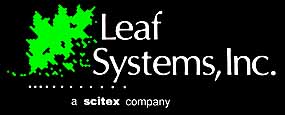Turning over a new Leaf
by John Henshall
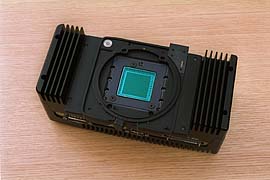
The Leaf Digital Camera Back showing the RZ mount and CCD.

When it comes to new technology, it's all too easy
for salesmen and engineers to pull the wool over our eyes. This simply may
be through the careful choice of subject, avoiding anything which shows
the product in its true colours, or the crafty application of computer enhancement
to make the picture look sharper. Or maybe it's that the equipment is so
difficult to operate that they, having known the product from "birth",
are the only ones ever likely to have the necessary know-how.
These are some of the reasons why I am so emphatic about testing equipment
myself, at leisure - if that's what you can call working through the night
at The Chip Shop!
The Leaf Digital Studio Camera back fits medium format cameras, such as
Hasselblad and Mamiya. It has made only fleeting visits to Britain from
its home in the USA, or parent company Scitex's European headquarters in
Belgium, or Hasselblad in Sweden, until Johnsons Photopia imported the first
camera for sale in Britain recently. Until now, it has been impossible to
test this camera without an engineer hovering nearby. At Photokina I managed
to take an image on the camera and bring it back to the UK in digital form,
for publication in The Photographer, but this is not the same as having
it in your own studio.
I collected the Leaf, together with a Mamiya RZ67 body and 60mm lens, from
Johnsons Photopia in Newcastle, Staffordshire, on 2 March 1993.
The Leaf kit is housed in a large, but not heavy, flight case which gives
the delicate CCD back and all the other hardware considerable protection.
There is quite a lot of peripheral hardware, and also special software needed
to control the camera, 'develop' its images, and to apply gain and blemish
corrections to each CCD chip.
Hardware includes the camera back itself, power supply, serial interface
converter box, tri-colour (RGB) front-of-lens motorised filter wheel, Atto
Silicon Express NuBus card and lots of special cables.
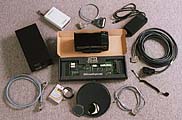
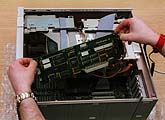
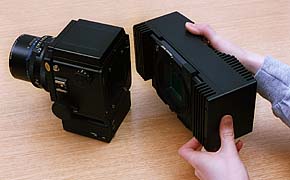
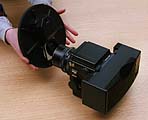
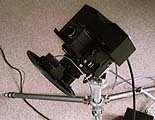
The camera needs an Apple Macintosh Quadra 950 or
800 computer with 64 megabytes of random access memory, a 300 megabyte (or
larger) hard drive and 24-bit video (which makes it able to display 16,777,216
colours), together with a nineteen inch colour monitor. The NuBus card speeds
the rate of transfer from the camera to the Macintosh.
The Leaf digital camera is called a 'Studio Camera', and that is really
all it can be as the camera must be controlled by powerful mains powered
computer equipment. This is a serious amount of equipment: just the 64 megabytes
of RAM for the Quadra costs £1800.
The camera back itself is very chunky, mainly due to its large cooling fins
which are necessary to keep the CCD at the right temperature. Temperature
control is important: CCDs are apt to give very 'noisy' (grainy) pictures
if they get too hot.
The square CCD chip itself is the real star of the show, the biggest I have
ever seen. It has 2048 by 2048 pixels giving a total of 4,194,304 individual
picture elements. A problem with all CCDs is that not all the pixels actually
work. A great number of CCDs must be made in order to get just one which
is good enough for use. Even this must have special individual correction
applied, to compensate for the 'dead' elements which would otherwise show
up as black or white spots in the picture.
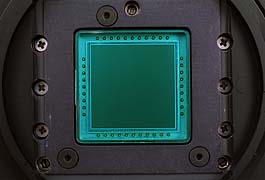
The Leaf back was fitted to the rear of the Mamiya
RZ67, the motorised filter wheel to the front of the 60mm lens. Despite
the large amount of hardware and software, the camera was readied for shooting
without any problem. Installation of the NuBus card in the Quadra was the
trickiest part: note the special wrist strap to avoid static electricity
damaging the chips on the card.
The Leaf is a monochrome camera which takes 'instantaneous' pictures. It
does not need continuous light and works very well with electronic flash.
To take colour pictures the Leaf takes three sequential exposures, using
a motorised filter wheel which has clear, red plus 0.6 neutral density,
green plus 0.8ND and blue filters. The three exposures are combined in the
computer to make a full-colour photograph. The disadvantage is that this
sequence takes 24 seconds, so only subjects which do not move may be photographed
- unless a neck clamp is used!
The Leaf CCD is approximately half the height and half the width of the
6x6cm film format, so the 60mm lens on the Leaf acts as a 120mm would on
6x6cm. A special viewfinder mask aids framing.
I wanted to choose one of the most difficult subjects I could find and I
did not need to look any further than home. My wife, Paulien, is a knitwear
designer. She spins her own wool from fleece which she dyes using natural
substances. The colours are brilliant but fall in difficult areas of the
spectrum, the fleece provides very fine detail at random angles. We arranged
the fleece in a wicker basket, to get some specular highlights in the picture.
This sat on a bed of finished knitwear, the patterns of knitting in which
might cause interference patterns with the regular laid out serried ranks
of pixels on the CCD.
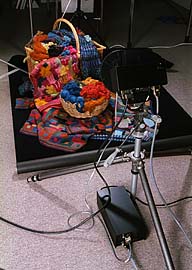
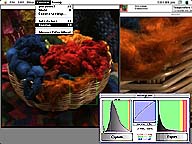
The camera has an ISO equivalent of 300 for black-and-white
imaging and only 14 to 16 for colour. I used softlight from studio flash,
with a single bare tube as backlight, to achieve a stop of 11.5. This gave
a quite precise zone of focus, with soft background. I used Adobe Photoshop
to apply an unsharp mask of 150% at 1 pixel radius. The result looks quite
superb on my computer monitor and on an 11 inch square print, produced on
the Kodak XL7700 printer. The photograph is reproduced on the cover direct
from the digital image file.
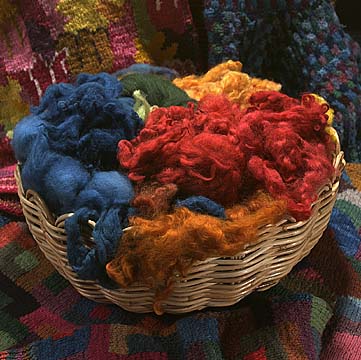
The camera is '14 bit' per colour (42 bit overall),
which means it can produce 16,384 discrete levels for each colour, a staggering
total of nearly 440 billion colours. These are sampled down by the software
to the usual 256 levels produced by 8 bit per colour (24 bit overall) systems.
What these staggering figures mean is that this camera has a nine stop dynamic
range. This actually beats film. The software allows you to 'develop' the
image and select which 8 bits per colour you wish to 'export' to programs
such as Adobe Photoshop. You can save the full 14 bit image and 'redevelop'
it time and time again - just as though you were redeveloping the same latent
image on film.
Some of the other pictures we made included classic cameras, with fine detail
and nickel plating, and a model truck, giving broad areas of saturated colour.
All potentially difficult subjects which the Leaf camera handles quite superbly.
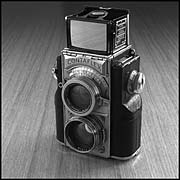
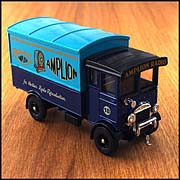
This report is peppered with big numbers. This camera
gives us thousands of pixels and billions of colours for its price of around
£25,000. It costs thousands of pounds for the biggest Macintosh computer,
its memory and hard drive. I have used nearly 400 megabytes of disc space,
just for the pictures for this column. To photograph the illustrations for
a catalogue would take many gigabytes. Yet, if you are in this or a similar
specialisation, it could well prove cost effective.
The Leaf is billed as a 'Digital Studio Camera'. 'Digital' and 'Studio'
it is but camera - like the Mamiya or Hasselblad it fits onto - it is not.
The Leaf is more like a film. And a very good film at that.
